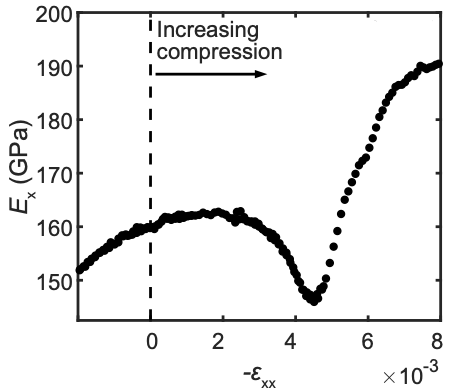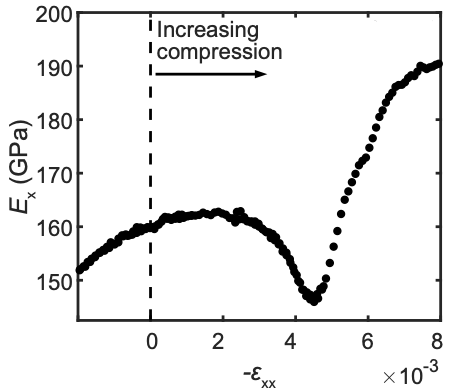Electrons Lead Their Lattice by the Nose
Electrons flowing through a crystal lattice don’t usually get to call the shots: their behavior is generally set by the lattice structure. But certain materials exhibit an electron–lattice coupling that allows the conduction electrons to influence the lattice behavior. This electron version of “wagging the dog” is predicted to be quite weak, making it a surprise that experiments with an unconventional superconductor now uncover a large electron-driven softening of the material’s lattice [1]. The finding could provide new insights into the mechanisms underlying unconventional superconductivity.
The lattice in a crystalline material is a periodic framework of atoms held together by electrostatic bonds. That framework dictates the properties of electrons moving through the material. For example, if the lattice is altered by applying mechanical strain or by adding dopant atoms, the electron momenta will correspondingly change, which can affect the material’s electronic band structure.
This subordinate status of the conduction electrons makes sense given their relatively small numbers, explains Hilary Noad from the Max Planck Institute for Chemical Physics of Solids in Germany. She notes that conduction electrons are outnumbered by valence electrons—those that stay fixed to the atoms and create the bonds that hold the lattice together. The valence electrons are the ones expected to control the elasticity, or softness, of a material, says Anna Böhmer, a solid-state experimentalist from Ruhr University Bochum in Germany who was not involved in the study. “Intuitively, the conduction electrons should have only a minor effect on lattice properties,” she adds.
Despite that general intuition, physicists have identified scenarios in which conduction electrons could have the upper hand. One of the first to suggest this possibility was Soviet physicist Ilya Lifshitz [2]. In 1960, he calculated that electrons could induce a softening of 0.01% of a conductor’s lattice structure if the energy landscape of the electrons suddenly changed. Such an electronic transition (now called a Lifshitz transition) occurs when the boundary between occupied and unoccupied electron states takes a different form. “Lifshitz included the prediction in a footnote because he expected the effect to be quite small,” Noad says. Now she and her colleagues have found a case that upsets that expectation.
The team performed experiments on the unconventional superconductor strontium ruthenate (Sr2RuO4). The material has a two-dimensional electronic structure in which electrons predominantly flow along flat planes within a crystal framework. The team placed a Sr2RuO4 crystal in a custom-built device that compressed it along a single axis, causing an observable shortening (strain) of the material. The device was simultaneously used to measure the stress in the material—its resistance to compression. And from those measurements, the team derived the elastic modulus, which quantifies the material’s stiffness.
The researchers observed that the stiffness initially increased with increasing strain, before taking a brief nosedive and then rising again. The abrupt stiffness dip occurred at a known Lifshitz transition in Sr2RuO4, suggesting that the electrons were responsible for the softening. To prove this electron dominance, the researchers explored the temperature dependence of the softening, which indicated that the softening was tied to a large increase in entropy in Sr2RuO4. That entropy jump could come from lattice excitations, but previous work showed that a lattice source was unlikely at the low temperatures (around 4 K) of the experiments. The team’s model instead indicates that the entropy jump is tied to a sudden spike at the Lifshitz transition in the density of electron states. “The basic picture I have is that suddenly the electrons can just do so much more, and that freedom makes the lattice softer,” Noad says.
The team estimated the lattice softening to be about 10%, roughly 1000 times larger than the softening Lifshitz predicted. “The lattice softening across the Lifshitz transition is remarkably large,” says condensed-matter theorist Rafael Fernandes from the University of Minnesota. He compares it to another softening that is associated with electronic nematics, an effect in which electron interactions induce a change in the rotational symmetry of a material, as happens, for example, in iron-based superconductors. Fernandes’ initial expectation was that the Lifshitz-related softening would be much smaller than the electronic-nematic softening, but they are roughly equal.
Fernandes says that Noad and colleagues give sound arguments for why the softening is so large—that Sr2RuO4 has unique properties (a two-dimensional character and a transition between correlated d orbitals) that lead to a stronger lattice sensitivity than seen for other conductors. “I think this work convincingly shows yet another case in which the lattice and the electronic system are not mere spectators of each other, but intertwined degrees of freedom,” Fernandes says.
With the lattice softening explained, Noad says that the top of her to-do list is now to investigate possible connections between this newly observed behavior and the superconducting properties of Sr2RuO4. She says that, intriguingly, the lattice softening occurs at a pressure where the superconducting transition temperature of Sr2RuO4 peaks. That could indicate that the unconventional superconductivity in Sr2RuO4 comes from some coupling between the electron and lattice systems, Noad says. Böhmer agrees that Sr2RuO4 is a remarkable material that may have more surprises. “The interrelation of electron and lattice properties is a really exciting topic at the forefront of current research in quantum materials,” she says.
–Michael Schirber
Michael Schirber is a Corresponding Editor for Physics Magazine based in Lyon, France.
References
- H. M. L. Noad et al., “Giant lattice softening at a Lifshitz transition in Sr2RuO4,” Science 382, 447 (2023).
- I. M. Lifshitz, “Anomalies of electron characteristics of a metal in the high pressure region,” Sov. Phys. JETP 11, 1130 (1960).







